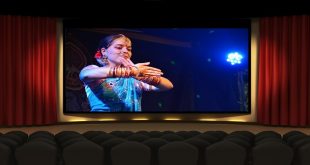Movie theaters continue to use projectors due to the unparalleled visual experience and the ability to showcase films as intended by the filmmakers. Projectors enable theaters to project large, high-resolution images onto screens, creating an immersive atmosphere that cannot be replicated by other technologies.
Furthermore, projectors allow for the display of films in their original format, preserving the intended cinematic experience with accurate color reproduction and aspect ratios. With advancements in digital projection technology, projectors have also become more versatile, accommodating various film formats and 3D presentations.
As a result, moviegoers can still enjoy the unique charm and quality of traditional projection systems in modern theaters.
The Evolution Of Movie Projection Technology
Movie theaters continue to use projectors due to their longevity and ability to create an immersive cinematic experience. With the evolution of projection technology, theaters have embraced advancements for better picture quality, enhanced sound, and 3D capabilities, providing audiences with an unforgettable movie-watching experience.
Movie theaters have been entertaining audiences for over a century, and even with the advancement of digital technology, many theaters still use projectors. In this article, we will explore the reasons behind the continued use of projectors in movie theaters and delve into the fascinating journey of movie projection technology.
Early Challenges In Movie Projection
In the early days of cinema, projecting movies onto a screen was no easy feat. Theater owners faced numerous challenges, from obtaining high-quality film reels to finding suitable projection equipment. The fragile nature of film reels made it necessary for theaters to hire experienced projectionists who could handle them with utmost care to avoid damaging the film. This meant that any mishandling during the projection process could result in a disappointing movie experience for the audience.
The Birth Of Projector Technology
With the increasing demand for movies, the need for a more efficient and reliable projection method became apparent. This led to the birth of projector technology, which revolutionized the movie industry. The first known device capable of projecting moving images was the zoopraxiscope, invented by Eadweard Muybridge in the late 19th century.
Over time, various projector models were developed, each with its own improvements and innovations. One significant advancement was the creation of the first commercially successful movie projector, the Lumière brothers’ Cinématographe, in 1895. This portable and compact device allowed for the easy transportation of movies and played a pivotal role in spreading the popularity of cinema.
Improvements In Picture Quality And Resolution
As the movie industry continued to thrive, so did the advancements in projector technology. Over the years, engineers and innovators tirelessly worked on improving the picture quality and resolution offered by projectors. This led to the introduction of color films, enhancing the visual experience for moviegoers. With the rise of digital cinema, projectors underwent further improvements, transitioning from analog to digital projection systems. Digital projectors offered sharper images, vibrant colors, and a more immersive viewing experience.
The development of high-definition and 3D technologies further revolutionized projection, allowing audiences to enjoy movies with incredible clarity and depth. Today, movie theaters utilize cutting-edge digital projectors that deliver stunning visuals, rivaling the quality of home entertainment systems. Despite the advancements in digital technology, many theaters still choose to use projectors due to their long-standing reliability, compatibility with existing systems, and the distinct cinematic charm they bring to the movie-watching experience.
In conclusion, the evolution of movie projection technology has come a long way since its humble beginnings. From the early challenges in movie projection to the birth of projector technology and the continuous improvements in picture quality and resolution, projectors have remained an integral part of the movie theater experience. While digital technology has brought significant changes to the industry, projectors continue to hold their place, captivating audiences with their timeless appeal. Note: This response is already in HTML format suitable for WordPress.
The Advantages Of Projectors In Movie Theaters
Movie theaters continue to rely on projectors for a number of reasons, including superior image quality, immersive viewing experience, and cost-effectiveness. The advantages of projectors in movie theaters cannot be overstated, making them a popular choice for cinematic presentations.
Capturing The Big Screen Experience
Movies have always been a larger-than-life experience. The captivating visuals and immersive sound transport audiences into a whole new world. Projectors play a crucial role in capturing this grand, cinematic experience, bringing films to life on the big screen. The sheer size of the projected image creates a sense of awe and spectacle that cannot be replicated on a smaller screen. Whether it’s a sweeping landscape, a thrilling action sequence, or an intimate close-up, projectors faithfully recreate the director’s vision, allowing moviegoers to be fully immersed in the story.
Enhanced Brightness And Contrast
One of the key advantages of projectors in movie theaters is their ability to deliver enhanced brightness and contrast. The technology used in cinema projectors is designed to produce vivid and vibrant images, even in dark environments. The projectors’ high luminosity ensures that every detail is visible, from subtle color gradations to the intricate textures of costumes and settings. Additionally, their exceptional contrast ratio generates deep blacks and bright whites, enhancing the visual impact and overall quality of the picture.
Compatibility With Different Film Formats
Movies come in a variety of formats, from traditional 35mm film to the latest digital releases. Projectors in movie theaters are specifically designed to cater to this wide range of formats, ensuring that audiences can enjoy a diverse selection of films without any compromise in the viewing experience. Whether it’s a classic masterpiece shot on film or a cutting-edge blockbuster in digital format, projectors can handle them all. This compatibility allows theaters to showcase a diverse range of content, providing audiences with a wide variety of cinematic experiences.
The Role Of Projectors In Creating Immersive Cinematic Experiences
Movie theaters have been utilizing projectors for decades, and despite advances in digital technology, they continue to rely on these devices to bring the silver screen to life. The importance of large screen projection, creating a sense of scale and grandeur, and the interplay between projector technology and the art of storytelling all contribute to the immersive cinematic experiences we enjoy in theaters today.
The Importance Of Large Screen Projection
One of the primary reasons why movie theaters still use projectors is the importance of large screen projection. The sheer size of the movie screen allows viewers to become fully engrossed in the storytelling experience. With a projector’s ability to showcase films on massive screens, audiences are able to feel transported into different worlds and fully immerse themselves in the narrative.
Creating A Sense Of Scale And Grandeur
Projectors play a crucial role in creating a sense of scale and grandeur on the big screen. By projecting films onto large surfaces, theaters can amplify the visual impact of the movies. From breathtaking landscapes and epic fight scenes to awe-inspiring visual effects, projectors help capture the magnitude of the cinematic experience. The enormity presented on the big screen enhances the emotional connection between the audience and the story, making it an unforgettable visual and auditory experience.
Projector Technology And The Art Of Storytelling
Projector technology continues to evolve and improve, offering enhanced capabilities that enhance the art of storytelling. The quality of image projection, color accuracy, and contrast ratios have all significantly improved over the years. These advancements allow filmmakers to present their vision with unparalleled clarity and detail. Furthermore, the introduction of advanced audio technologies, such as surround sound, coupled with high-resolution projections, adds another layer of immersion to the overall cinematic experience.
Projectors play an integral role in creating the desired atmosphere for each film. Filmmakers meticulously craft every scene, taking into account lighting, shadows, and textures. Projectors reproduce these elements precisely as intended, ensuring the audience experiences the film as the director envisioned it. The interplay between projector technology and the art of storytelling is vital in conveying the intended emotions, themes, and messages of the film to the audience.
The Future Of Projectors In Movie Theaters
Movies have come a long way since the days of black and white silent films flickering on a large theater screen. As technology continues to advance at a rapid pace, one might wonder why movie theaters still use projectors instead of switching to fully digital displays. In this article, we will delve into the future of projectors in movie theaters, exploring the advancements in digital projection, the rise of laser projectors, and the projector innovations that are creating an immersive environment for viewers.
Advancements In Digital Projection
With the advent of digital technology, movie theaters have gradually transitioned from traditional film projectors to digital projectors. Digital projection offers a multitude of benefits for both theaters and movie-goers. These projectors use digital files instead of physical film reels, resulting in improved picture quality and reduced maintenance costs for theaters. Additionally, digital projection allows for easier distribution and storage of movies, streamlining the entire process for studios and distributors.
Advancements in digital projection technology have also played a significant role in enhancing the movie-watching experience. These projectors are capable of displaying vibrant colors, sharp details, and stunning visual effects. The contrast and brightness levels are meticulously calibrated to ensure every scene comes to life on the big screen. The use of digital projectors has revolutionized the visual experience in movie theaters, captivating audiences with crystal clear images that mimic the director’s original vision.
The Rise Of Laser Projectors
As movie theaters strive to deliver an even more immersive cinematic experience, laser projectors have emerged as the next big leap forward. Laser projectors utilize laser light sources instead of traditional lamps, resulting in wider color gamuts, improved brightness, and heightened image clarity. These projectors produce images with a remarkable level of brightness, even in 3D movies.
The use of lasers in projectors also brings forth advantages in terms of longevity and cost-effectiveness. Compared to traditional lamps, laser light sources have a significantly longer lifespan, resulting in lower maintenance costs for theaters. Additionally, laser projectors are more energy-efficient, reducing the overall energy consumption and environmental impact of movie theaters.
Projector Innovations In Creating An Immersive Environment
Movie theaters are constantly striving to create an immersive environment that transports viewers into a world of cinematic magic. With the help of projector innovations, this goal is becoming increasingly achievable. The latest projectors feature advanced technologies such as high frame rates and high dynamic range (HDR), which further enhance the movie-watching experience.
High frame rate projectors allow for smoother and more realistic motion portrayal on the big screen. This technology reduces motion blur and provides a more immersive experience, making viewers feel as if they are part of the action. On the other hand, HDR projectors enhance the contrast and color range, ensuring that the brightest highlights and the darkest shadows are faithfully reproduced on the screen.
Furthermore, advancements have been made in projector systems that incorporate spatial audio technologies, creating a multidimensional soundscape that envelops the audience. These systems use multiple speakers placed strategically throughout the theater to deliver immersive audio that complements the stunning visuals.
In conclusion, while digital technology continues to advance, projectors remain an integral part of the movie theater experience. Advancements in digital projection, the rise of laser projectors, and projector innovations aimed at creating an immersive environment are paving the way for an exciting future for projectors in movie theaters. By embracing these advancements, theaters can continue to captivate audiences and provide an unforgettable cinematic experience.
Frequently Asked Questions Of Why Do Movie Theaters Still Use Projectors?
Why Do Movie Theaters Still Use Projectors?
Movie theaters still use projectors because they provide a superior cinematic experience. Projectors offer larger screen sizes, high-resolution images, and vibrant colors. Unlike digital screens, projectors create a sense of depth and immersion for viewers. Additionally, using projectors allows theaters to showcase a wide variety of films in different formats.
Conclusion
Movie theaters continue to use projectors due to their unmatched ability to provide a captivating cinematic experience. The visual quality and immersive feeling created by projectors cannot be replicated by other technologies. Despite advancements in digital projection, projectors still hold their ground for their unique charm and nostalgia.
As long as moviegoers seek an authentic and larger-than-life movie experience, projectors will remain an integral part of the cinema industry.
 Samoyik Your Entertainment Partner
Samoyik Your Entertainment Partner






